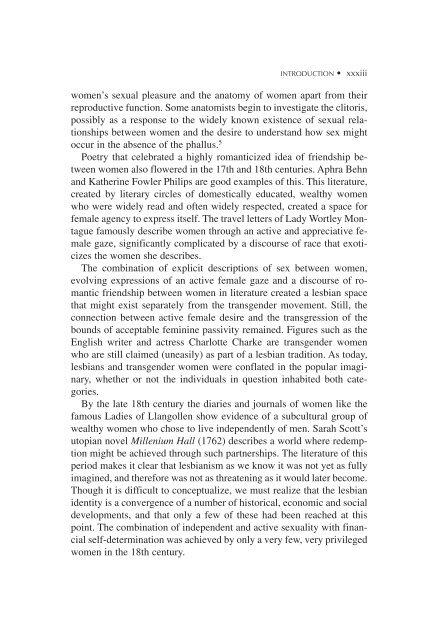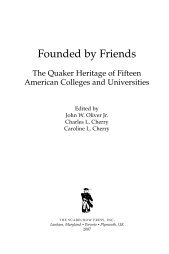Historical Dictionary of Lesbian Literature - Scarecrow Press
Historical Dictionary of Lesbian Literature - Scarecrow Press
Historical Dictionary of Lesbian Literature - Scarecrow Press
You also want an ePaper? Increase the reach of your titles
YUMPU automatically turns print PDFs into web optimized ePapers that Google loves.
INTRODUCTION • xxxiii<br />
women’s sexual pleasure and the anatomy <strong>of</strong> women apart from their<br />
reproductive function. Some anatomists begin to investigate the clitoris,<br />
possibly as a response to the widely known existence <strong>of</strong> sexual relationships<br />
between women and the desire to understand how sex might<br />
occur in the absence <strong>of</strong> the phallus. 5<br />
Poetry that celebrated a highly romanticized idea <strong>of</strong> friendship between<br />
women also flowered in the 17th and 18th centuries. Aphra Behn<br />
and Katherine Fowler Philips are good examples <strong>of</strong> this. This literature,<br />
created by literary circles <strong>of</strong> domestically educated, wealthy women<br />
who were widely read and <strong>of</strong>ten widely respected, created a space for<br />
female agency to express itself. The travel letters <strong>of</strong> Lady Wortley Montague<br />
famously describe women through an active and appreciative female<br />
gaze, significantly complicated by a discourse <strong>of</strong> race that exoticizes<br />
the women she describes.<br />
The combination <strong>of</strong> explicit descriptions <strong>of</strong> sex between women,<br />
evolving expressions <strong>of</strong> an active female gaze and a discourse <strong>of</strong> romantic<br />
friendship between women in literature created a lesbian space<br />
that might exist separately from the transgender movement. Still, the<br />
connection between active female desire and the transgression <strong>of</strong> the<br />
bounds <strong>of</strong> acceptable feminine passivity remained. Figures such as the<br />
English writer and actress Charlotte Charke are transgender women<br />
who are still claimed (uneasily) as part <strong>of</strong> a lesbian tradition. As today,<br />
lesbians and transgender women were conflated in the popular imaginary,<br />
whether or not the individuals in question inhabited both categories.<br />
By the late 18th century the diaries and journals <strong>of</strong> women like the<br />
famous Ladies <strong>of</strong> Llangollen show evidence <strong>of</strong> a subcultural group <strong>of</strong><br />
wealthy women who chose to live independently <strong>of</strong> men. Sarah Scott’s<br />
utopian novel Millenium Hall (1762) describes a world where redemption<br />
might be achieved through such partnerships. The literature <strong>of</strong> this<br />
period makes it clear that lesbianism as we know it was not yet as fully<br />
imagined, and therefore was not as threatening as it would later become.<br />
Though it is difficult to conceptualize, we must realize that the lesbian<br />
identity is a convergence <strong>of</strong> a number <strong>of</strong> historical, economic and social<br />
developments, and that only a few <strong>of</strong> these had been reached at this<br />
point. The combination <strong>of</strong> independent and active sexuality with financial<br />
self-determination was achieved by only a very few, very privileged<br />
women in the 18th century.
















